

Canon EOS R100: the smallest, lightest and most affordable of Canon’s mirrorless system cameras also excels when used with a microscope
Weighing in at just around 350 grams, the Canon EOS R100 is one of the lightest mirrorless system cameras around. Its slim and compact design makes it a particularly good fit for slimmer microscopes, and its low weight is a major advantage when the camera is attached to the eyepiece tube of a microscope using one of our LM adapter solutions. When used as a “high-end USB eyepiece camera”, the EOS R100, thanks to its large, high-quality APS-C sensor, produces better image than many standard microscope cameras. Additionally, with our LM microscope adapters, it can also be attached to microscopes that are equipped with a phototube. Released in June 2023, the EOS R100 carries a relatively moderate price tag of around € 600 (body only).
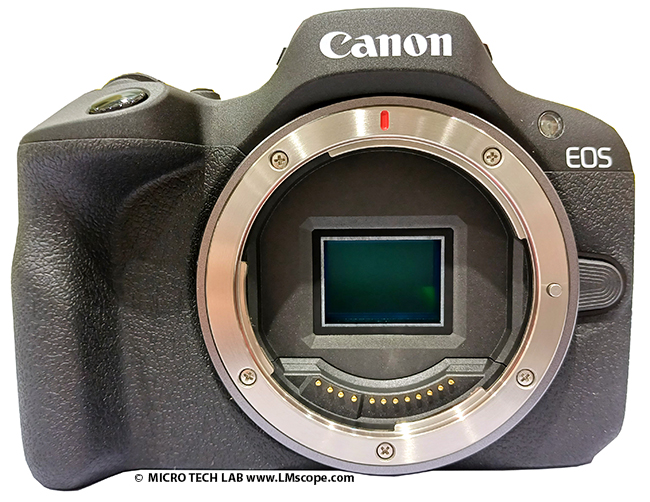
Key specifications
- 24 MP APS-C (22.5 mm x 15.0 mm) CMOS imaging sensor
- Canon RF bayonet port
- Continuous shooting at up to 6.5 frames per second at highest resolution for a maximum of 97 frames
- ISO range of 100 to ISO 25,600
- Movie recording frame size (pixels) and frame rate: 3,840 x 2,160 (4K UHD) up to 25p, maximum recording time 30 minutes
- Fixed 3.0" (7.5 cm) non-touch TFT LCD screen
- Shutter speeds between 1/16,000 and 30 seconds, bulb function
- SD card slot (up to UHS I), compatible with UHS II
- Standard Canon LP-E17 battery
- USB 2.0 type C
- HDMI micro out terminal (type D) to display the live image on an external monitor
- Built-in Wi-Fi (wireless LAN), Bluetooth technology
- Weight: 356 g (body only)
With our LM microscope adapters, the EOS R100 can be attached to the phototube of many different microscopes. Our adapters have a built-in optical system that is matched exactly to the sensor size of the camera, resulting in superior image quality and a wide field of view.
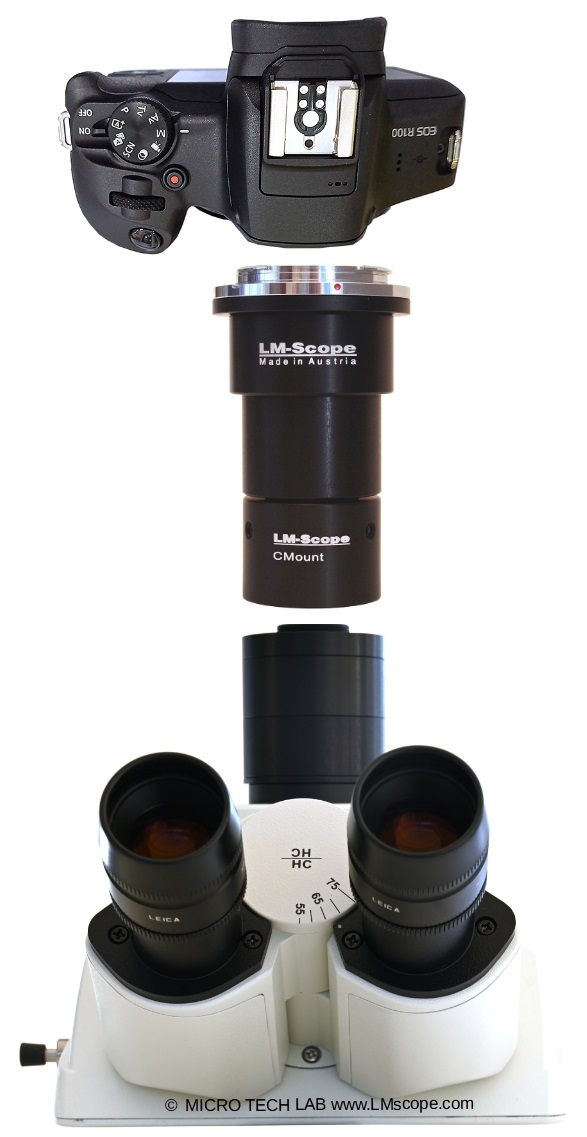
If the microscope doesn’t have a phototube, the EOS R100 can also be attached to the eyepiece tube by removing one eyepiece and putting the camera-adapter combination into its place. Its small and lightweight design makes it ideal for this method of installation.
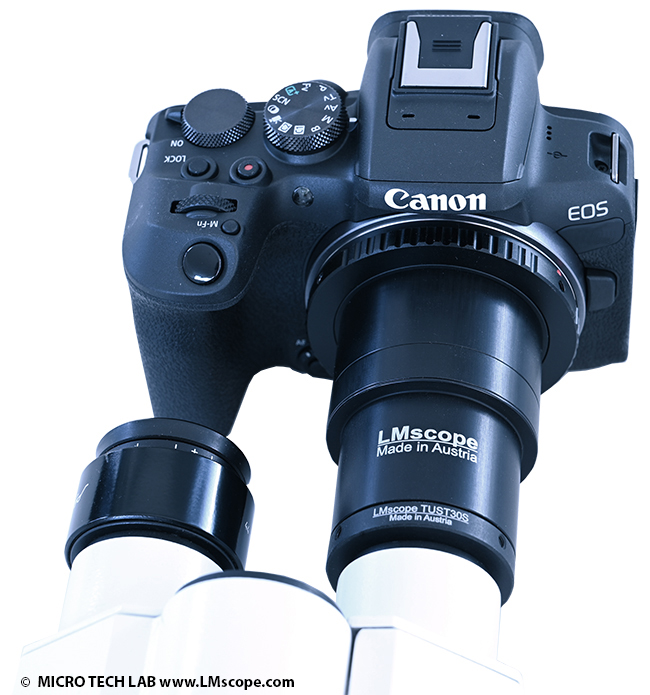
For standard applications, we recommend working in AV mode with automated aperture priority. In this shooting mode, the camera automatically selects the required shutter speed. If required, the brightness of the image can be adjusted in the menu. For more specialised imaging tasks, the camera can also be used in manual (M) mode.
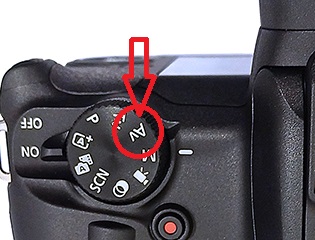
Before starting microscope work, the “Release w/o Lens setting” should be enabled in the camera menu.
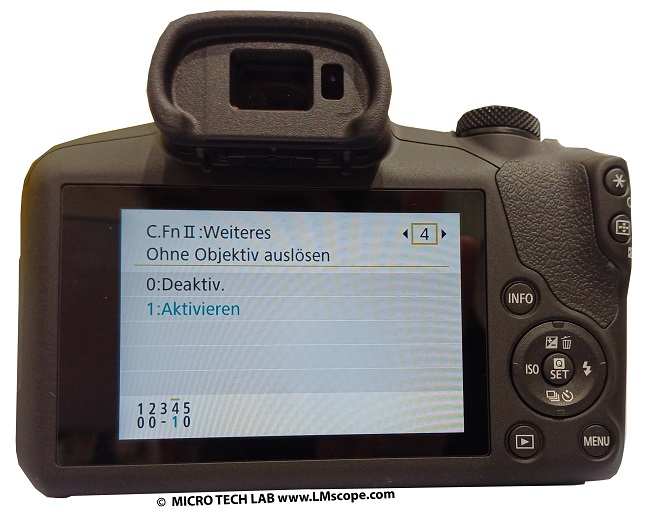
The 3'' (7.5 cm) LCD screen at the rear of the camera is fixed and has no touch functions. Unlike the R100, most current DSLR and mirrorless system cameras in the higher price segment do have a touchscreen display that can either be folded or swivelled and tilted. Although a screen with articulation options is generally a useful feature, the screen is not used very much when the camera is operated in a stationary position with Canon’s EOS Utility software, which we recommend for fast and ergonomic work. For remote camera control, the camera can be connected to the computer with a USB cable (USB 2.0 port).
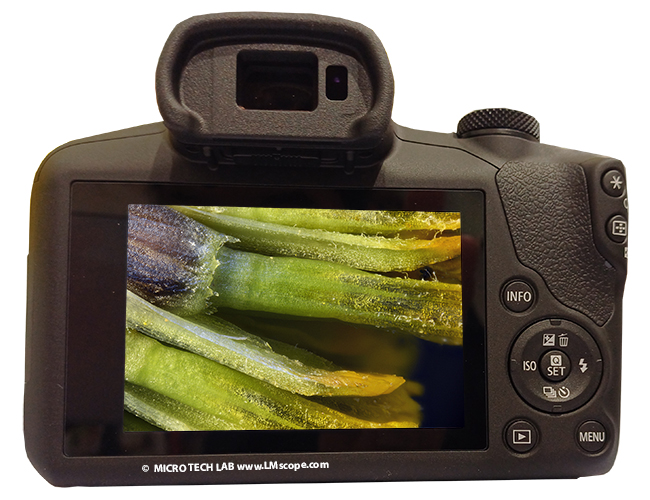
The EOS Utility software enables remote camera control and remote shooting, and the captured images can be saved directly to the PC. The software is included free of charge with Canon cameras. A variety of settings can be adjusted in Live View mode, such as ISO, image quality, exposure duration, image format, gridlines, image rotation, magnifying function for precise focusing, white balance with eyedropper symbol, storage location for photos and videos, and more.
As an alternative to controlling the camera remotely from the computer with the EOS Utility software, it can be connected to a large monitor using the built-in HDMI output and an HDMI cable. The large live image displayed on the monitor can be used for focusing and adjusting the settings and also for presentations and similar activities.
The EOS R100 can shoot at up to 6.5 frames per second (fps) in continuous shooting mode at the highest resolution, which places it in the mid-range category. On the plus side, the camera achieves a shutter speed of 1/16,000 seconds when the electronic shutter is activated, which is great for capturing moving subjects without blurring them.
ISO speed (light sensitivity) can be set between 100 and 25,600 in manual mode. The sensor of the EOS R100 is highly sensitive to light, making it a good fit for fluorescence microscopy. However, we generally recommend selecting the lowest ISO possible in order to get the highest dynamic range.
In video mode, the user can choose between 4K format (with 25 fps) and Full HD with up to 60 fps. The recording time is limited to 30 minutes.
Conclusion: The EOS R100 is well suited for use with a microscope. We recommend controlling the camera remotely with the EOS Utility software. It is an affordable entry point to Canon’s lineup of mirrorless system cameras and an excellent alternative to traditional C-mount microscope cameras, thanks to its large, high-quality sensor that delivers superior image quality, dynamic range and light sensitivity. Because it is produced in large quantities, this camera offers a much better price-performance ratio than specialised microscope cameras. If you have a little more to spend, the EOS R10 is also a good alternative to consider.
08.09.2023Photography:
Fitting the microscope to digital single-lens reflex (DSLR), mirrorless interchangeable-lens cameras (MILC ), digital single-lens mirrorless (DSLM) or C-mount cameras is easy with our LM digital SLR adapters, which feature a plan achromatic optical system. Our products make it possible to capture top-quality microscope images. To help you select the adapter that is right for your camera, we have set up an online configurator on our website. You can also email us – ideally with attached photographs of your microscope.
Modern DSLR and single-lens mirrorless (DSLM) offer the latest technology and are generally very well suited for microscopy applications. Most of them can be controlled remotely via PC/Mac. Because of their high sales volumes, they offer an excellent price/performance ratio compared to special-purpose microscope cameras.
Features of top DSLR and single-lens mirrorless cameras (DSLM):
- Large, powerful full-frame sensors (36 x 24 mm)
- Sensor resolution of 61 megapixels or 240 megapixels with Pixel Shift technology
- High light sensitivity (ISO 400,000+)
- Extensive dynamic range (up to 15 aperture stops/f-stops)
- Short exposure times (1/8000 second) up to 1/32,000 seconds using the digital shutter
- 4K Ultra HD or 8K Ultra HD video function
- Live video capture on external monitors in ultra HD quality
In most cases, these cameras are significantly more powerful than microscope cameras with smaller sensors (1/2" or 2/3"). On our website you will find our current camera recommendations and a camera ranking which is specifically tailored to microscopy applications.